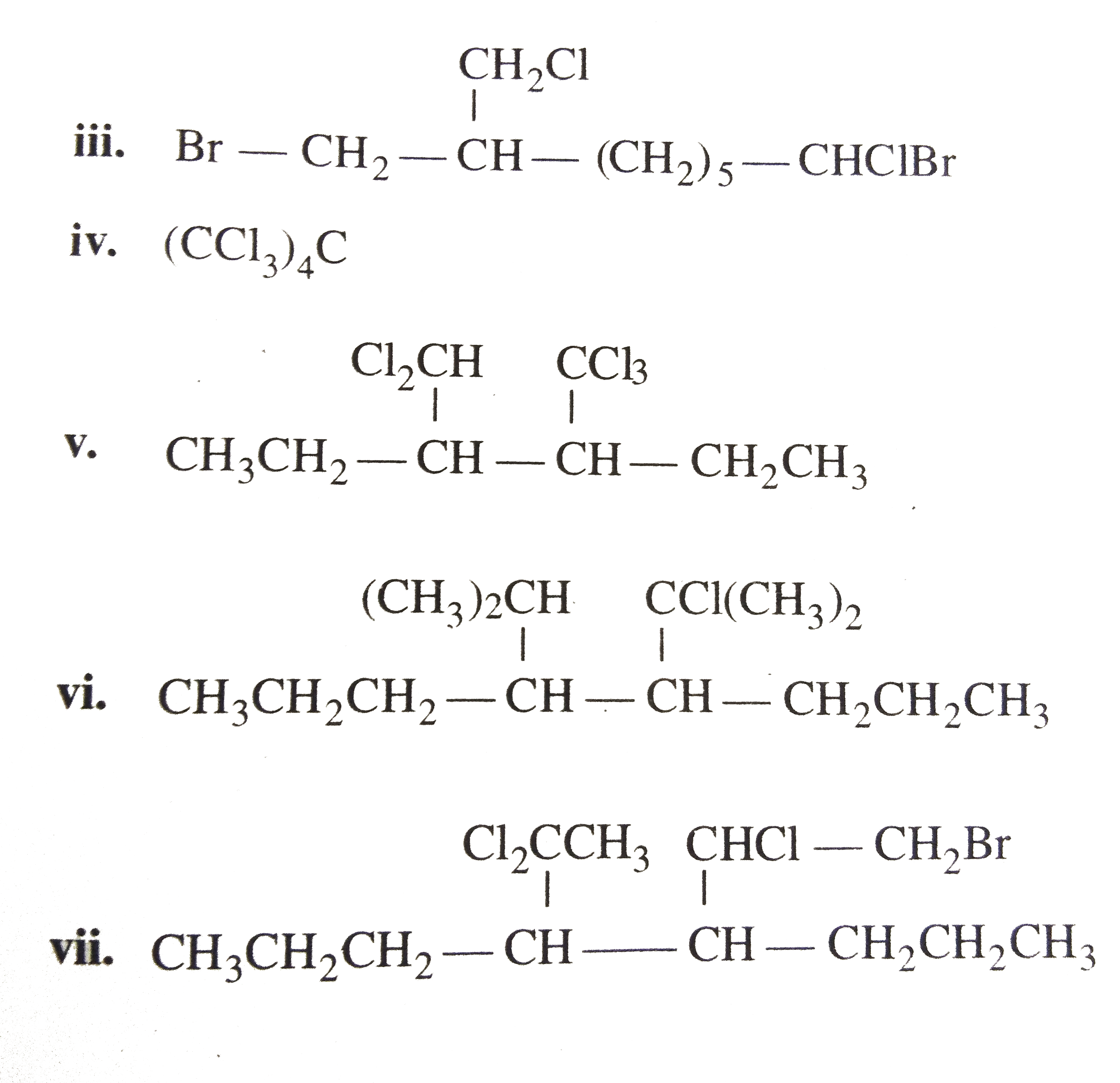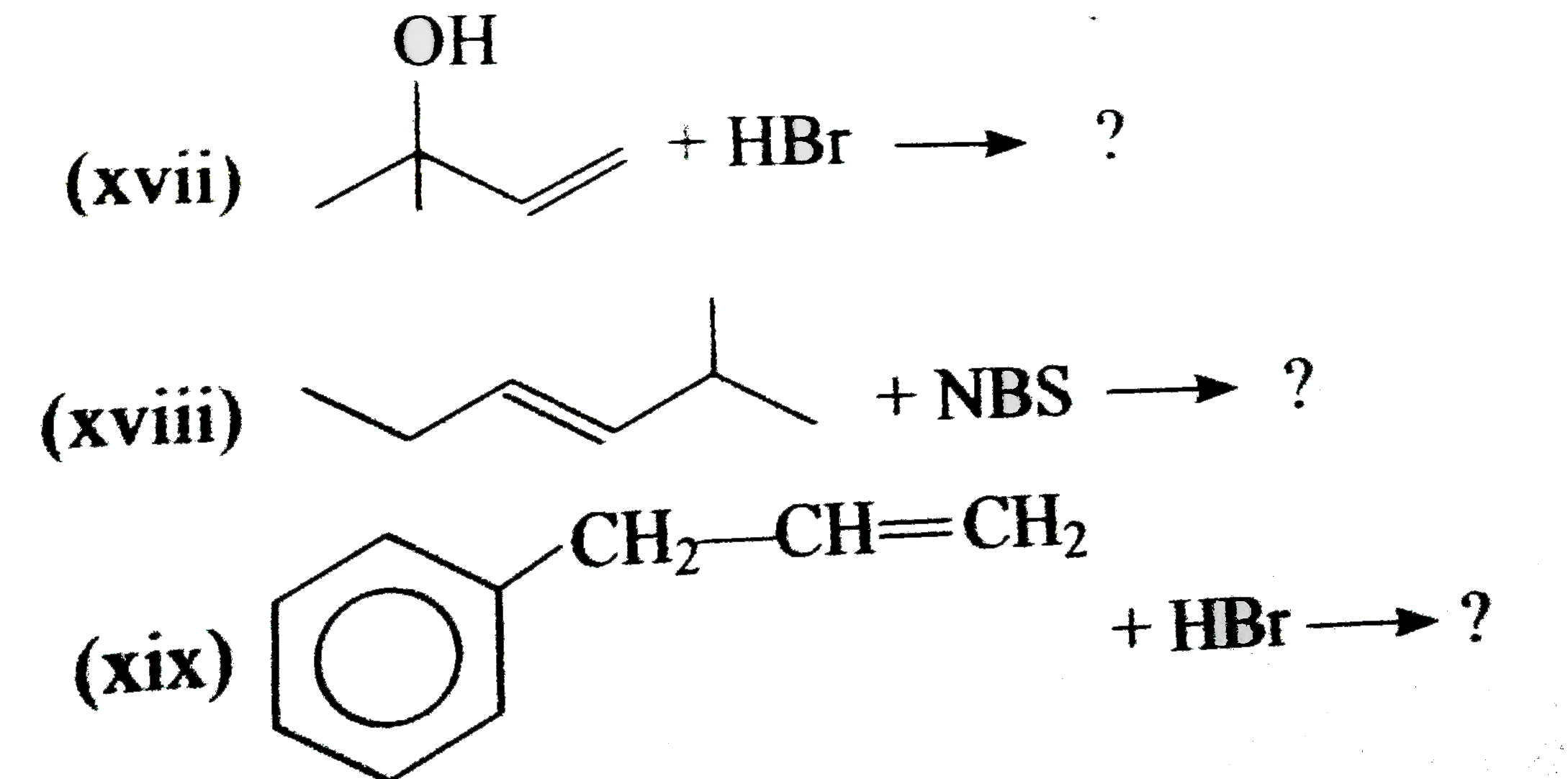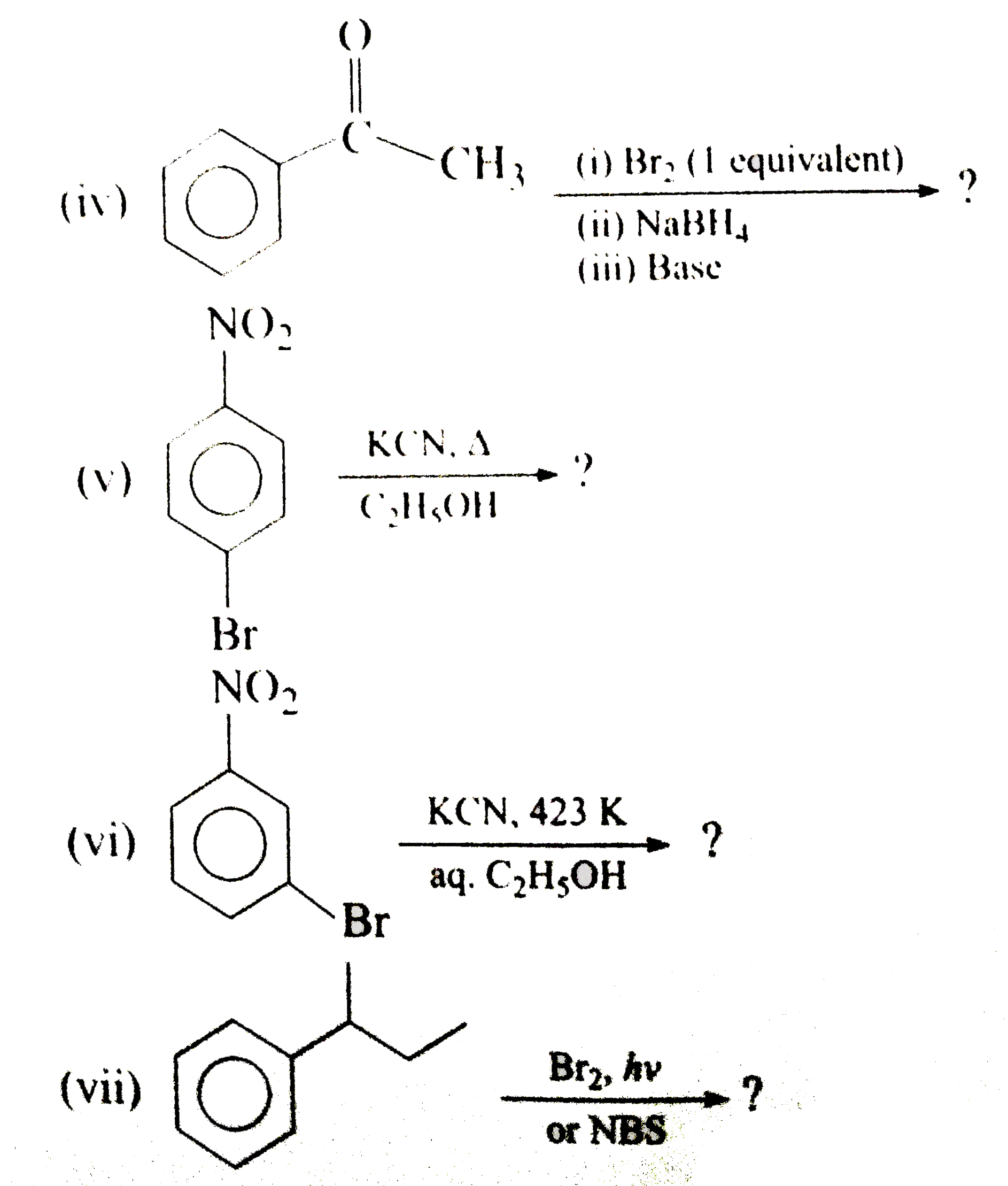CH3CH=CH−CH3+Br2→CH3−C∣BrH−C∣BrH−CH3 is an
Substitution reaction
Elimination reaction
Electrophilic addition reaction
Nucleophilic addition reaction
To solve the question regarding the reaction of 2-butene (CH₃CH=CHCH₃) with bromine (Br₂), we will analyze the type of reaction that occurs.
1. Identify the Reactants and Products:
- The reactant is 2-butene (CH₃CH=CHCH₃) and the product is a dibromide (CH₃BrCBrC(CH₃)H).
2. Determine the Type of Reaction:
- The reaction involves the addition of bromine across the double bond of 2-butene. This indicates that it is an addition reaction.
3. Mechanism of the Reaction:
- The double bond in 2-butene acts as a nucleophile and attacks the bromine molecule (Br₂). This leads to the formation of a bromonium ion intermediate.
- The bromonium ion is formed when one of the bromine atoms forms a bond with one of the carbon atoms of the double bond, creating a three-membered ring structure.
4. Formation of the Bromonium Ion:
- The bromonium ion is a cyclic structure where the positive charge is stabilized by the adjacent carbon atoms. This intermediate is crucial for the next step of the reaction.
5. Nucleophilic Attack:
- The other bromine atom (Br⁻) acts as a nucleophile and attacks the more substituted carbon of the bromonium ion, leading to the formation of the final product, which is a vicinal dibromide.
6. Conclusion:
- Since the reaction involves the addition of bromine across a double bond and the formation of a bromonium ion, it is classified as an electrophilic addition reaction.
Final Answer:
The reaction of CH₃CH=CHCH₃ with Br₂ is an electrophilic addition reaction.
---
- The reactant is 2-butene (CH₃CH=CHCH₃) and the product is a dibromide (CH₃BrCBrC(CH₃)H).
- The reaction involves the addition of bromine across the double bond of 2-butene. This indicates that it is an addition reaction.
- The double bond in 2-butene acts as a nucleophile and attacks the bromine molecule (Br₂). This leads to the formation of a bromonium ion intermediate.
- The bromonium ion is formed when one of the bromine atoms forms a bond with one of the carbon atoms of the double bond, creating a three-membered ring structure.
- The bromonium ion is a cyclic structure where the positive charge is stabilized by the adjacent carbon atoms. This intermediate is crucial for the next step of the reaction.
- The other bromine atom (Br⁻) acts as a nucleophile and attacks the more substituted carbon of the bromonium ion, leading to the formation of the final product, which is a vicinal dibromide.
- Since the reaction involves the addition of bromine across a double bond and the formation of a bromonium ion, it is classified as an electrophilic addition reaction.
The reaction of CH₃CH=CHCH₃ with Br₂ is an electrophilic addition reaction.
Topper's Solved these Questions
- ORGANIC CHEMISTRY : SOME BASIC PRINCIPLES AND TECHNIQUES BOOK - AAKASH INSTITUTECHAPTER - ORGANIC CHEMISTRY : SOME BASIC PRINCIPLES AND TECHNIQUES EXERCISE - Assignment(SECTION B)
3 Videos
- ORGANIC CHEMISTRY : SOME BASIC PRINCIPLES AND TECHNIQUES BOOK - AAKASH INSTITUTECHAPTER - ORGANIC CHEMISTRY : SOME BASIC PRINCIPLES AND TECHNIQUES EXERCISE - Assignment(SECTION C)
37 Videos
- ORGANIC CHEMISTRY : SOME BASIC PRINCIPLES AND TECHNIQUES BOOK - AAKASH INSTITUTECHAPTER - ORGANIC CHEMISTRY : SOME BASIC PRINCIPLES AND TECHNIQUES EXERCISE - Exercise
64 Videos
- MOCK_TEST_20BOOK - AAKASH INSTITUTECHAPTER - MOCK_TEST_20EXERCISE - EXAMPLE
28 Videos
- ORGANIC CHEMISTRY: SOME BASIC PRINCIPLE AND TECHNIQUESBOOK - AAKASH INSTITUTECHAPTER - ORGANIC CHEMISTRY: SOME BASIC PRINCIPLE AND TECHNIQUESEXERCISE - TRY YOURSELF
28 Videos
Similar Questions
Knowledge Check
The IUPAC name of CH3−CH∣CI−CH∣Br−CH∣OH−CH3 is:
A3-Bromo-4-chloropentan-2-olB3-Bromo-2-chloro-4-hydroxypentaneC3-Bromo-2-chloropentane-4-olDnone of theseArrange the following compounds in increasing order of their boiling points.
 , (ii) CH3CH2CH2CH2Br
, (ii) CH3CH2CH2CH2Br
(iii) H3C−CH3C∣∣Br−CH3A(ii)<(i)<(iii)B(iii)<(ii)<(i)C(iii)<(i)<(ii)D(iii)<(ii)<(i)The IUPAC name of
CH3−CH∣OH−CH2−CH2−CH2−Br∣C∣Br−CH3A6,6−Dibromoheptan−2−olB2,2−Dibromoheptan−6−olC6,6−Dibromoheptan −2−alDNone of these
CH3−C∣ClH−C∣IH−CH3
CH3−C∣CH3H−(CH2)4−C∣CH3H−C∣BrH−CH2CH3


View SolutionName the following compounds accoring to IUPAC system :
(i) CH3−CH2−CH∣CH2Cl−CH2OH∣CH−CH∣CH3−CH3(ii)CH3−CH∣CH3−CH2−CH∣OH−CH2OH∣CH−CH3
(iii) (iv) H2C=CH−CH∣OH−CH2−CH2−CH3
(iv) H2C=CH−CH∣OH−CH2−CH2−CH3
(v) CH3−C∣CH3=C∣Br−CH2OH
View Solution(A) What is the final product in each reaction?
(i)C2H5OHI2−−−−−−→NaOH
(ii)CHCI3Ag−−−−−→Heat?
(iii)CHCI3HNO3−−−→?
(iv)CI4Fe/H2O−−−−→?
(v)C6H5NH2CHCI3−−−−−→KOH?
(vi)C4H9BrNaNO2/C2H5OH−−−−−−−−−−→?

(ix)CH3LiCH2=CH2−−−−−−→?
(x)(CH3)3CCI(CH3)2Zn−−−−−−→?
(xi)H2C=CH3∣C−CH2CH3IBr−−→?
(xii)CH3−CH−CH2NBS−−→?
(xiii)CH3−C∣CH3H−CH2CINaI−−−−−−−−−→Acetone,Δ?
(xiv)R3MgX(CH3)2CO/H2O−−−−−−−−−−→?
(xv)CH3−C∣BrH−C∣CH3H−CH3+HBr→?
(xvi)CH3−C∣CH3H−C∣OHH−CH3+HBr→?

(xx)CH3−CH3∣C∣CH3−C∣CIH−CH3+KOH(alc)→?
(xxi)(CH3)3C−CH2Br+KOH(alc)→?
(xxii)CH3−CH3∣C∣CH3−CH2Br+C2H5OHHeat−−→?

(B)(i)C6H5CH2CH3Br2−−−−−→hv?
(ii)C6H5CH2CH3(i)Br2,heat ,light−−−−−−−−−−−−−−→(ii)NaCN,H2O/H?
(iii)CICH2CH2CH2COPhKOH−−−−−−→MeOH?


View SolutionWhich alkyl halide from the following pairs would you expect to react more rapidly by an SN2 mechanism? Explain your answer.
(i)CH3CH2CH2CH2BrorCH3CH2C∣BrHCH3,(ii)CH3CH2C∣BrHCH3orH3C−CH3∣C∣CH3−Br
(iii)CH3C∣CH3HCH2CH2BrorCH3CH2C∣CH3HCH2Br
View SolutionState which of these exhibit stereoisomerism and of what type?
(a) CHCH2−Br∣C=Br∣C−CH2Cl
(b) Cl−CH2−C∣∣O−CH2−CH∣CH3−CH3
(3) CH3−Cl∣CH−CH∣Br−CH2−CH2−CH2−CH3∣CH−CH3
(d) CH3−CH2−CH(OH)COOH
(e) CH3CH=CHC2H5
(f) CH3CH(Br)COOH
(g) H2C=C(CH3)2
(h) C2H5CH=CHCl
(i) 1-Bromo-3-chlorocyclobutane
(j) 1,4-Dimethylcyclohexane
View Solution
